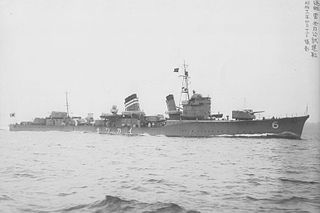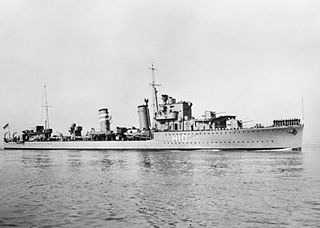
Ikazuchi was the twenty-third Fubuki-class destroyer, or the third Akatsuki class, built for the Imperial Japanese Navy in the inter-war period. When introduced into service, these ships were the most powerful destroyers in the world. They remained formidable weapons systems well into the Pacific War.

Yukikaze was a Kagerō-class destroyer in service with the Imperial Japanese Navy during World War II. She was the only member of her class to survive the war, and did so without suffering any major damage. Following the war, the ship was transferred to the Republic of China Navy, where she was renamed Dan Yang and served until 1966, before being scrapped in 1970.

USS Hardhead (SS-365), a Balao-class submarine, was a ship of the United States Navy named for the hardhead, a fish of the croaker family. Hardhead received six battle stars for World War II service. All six of her combat patrols were "successful".

Yūgure was the sixth and last Hatsuharu-class destroyer, built for the Imperial Japanese Navy under the Circle One Program. Three were laid down in JFY 1931 and the next three in JFY 1933.

The Taiyō-class escort carrier was a group of three escort carriers used by the Imperial Japanese Navy (IJN) during World War II. Two of the ships were built as cargo liners in the late 1930s and subsequently taken over by the IJN and converted into escort carriers, while the third ship was converted while still under construction. The first ship converted, Taiyō, ferried aircraft and supplies to Japanese possessions before the start of the Pacific War in December 1941 and also served as a training ship between transport missions. Once the war began she did much the same for the newly conquered areas. Her sister ship, Un'yō did much the same in 1942. Chuyō, the last of the three to be converted, only ferried aircraft between Japan and the naval base at Truk before she was sunk by an American submarine in December 1943. Her sisters sometimes had other destinations other than Truk in 1943, but it was also their primary destination until they were damaged by American submarines in late 1943 or early 1944. After finishing their repairs in 1944, the sisters combined convoy escort duties with their transport missions and often ventured as far south as Singapore. Taiyō was the first of the pair to be sunk, torpedoed by an American submarine in August, with Un'yō following her sister a month later.

HMS Encounter was an E-class destroyer built for the Royal Navy in the early 1930s. Although assigned to the Home Fleet upon completion, the ship was attached to the Mediterranean Fleet in 1935–36 during the Abyssinia Crisis. During the Spanish Civil War of 1936–39, she spent considerable time in Spanish waters, enforcing the arms blockade imposed by Britain and France on both sides of the conflict. Encounter was assigned to convoy escort and anti-submarine patrol duties in the Western Approaches, when World War II began in September 1939. She participated in the Norwegian Campaign before joining Force H in mid-1940 and was present during the Battles of Dakar and Cape Spartivento later that year. The ship was transferred to the Mediterranean Fleet in 1941 where she escorted convoys to Malta.

The Ukuru-class escort ships were a class of twenty kaibōkan escort vessels built for the Imperial Japanese Navy during World War II. The class was also referred to by internal Japanese documents as the "Modified B-class" coastal defense vessel, and they were the fourth class of kaibōkan.

Lepanto was an Azio-class minelayer of the Italian Navy. She was reclassified as gunboat in 1934 and remained in Italian service in the far east from 1933 to 1943, when she was scuttled in China, during World War II. She was then recovered by the Imperial Japanese Navy and taken into service as Okitsu, spending the remainder of the war escorting convoys. She was surrendered to the Republic of China after the end of the war and served for a further ten years with its navy as the Hsien Ning.

Komahashi (駒橋), was an auxiliary vessel operated by the Imperial Japanese Navy, serving from the 1910s through World War II. Her classification changed numerous times during her operational life. Although officially designated as a submarine tender for most of her career, Komahashi very rarely functioned in this role, but was used instead as an oceanographic survey vessel throughout the Pacific, and as a kaibokan escort vessel for convoys of merchant ships during the Pacific War.

Kaibōkan or coastal defense ship was a type of naval ship used by the Imperial Japanese Navy during World War II for escort duty and coastal defense. The term escort ship was used by the United States Navy to describe this category of Japanese ships.
CD-118 or No. 118 was a Type D escort ship of the Imperial Japanese Navy during World War II.
CD-13 was a Type C escort ship (Kaibōkan) of the Imperial Japanese Navy during the Second World War.
CD-47 was a C Type class escort ship (Kaibōkan) of the Imperial Japanese Navy during the Second World War.
CD-160 or No. 160 was a Type D escort ship of the Imperial Japanese Navy during World War II.
CD-154 or No. 154 was a Type D escort ship of the Imperial Japanese Navy during World War II.
Sanuki Maru (Japanese:讃岐丸) was a 1939-built cargo ship, requisitioned as a seaplane tender by the Imperial Japanese Navy during World War II.
CD-53 was a C Type class escort ship (Kaibōkan) of the Imperial Japanese Navy during the Second World War.
Patrol Boat No. 105 (第百五號) (ex-Arayat) was a former Philippine Commonwealth customs inspection and enforcement cutter that was sunk by the Japanese during the invasion of the Philippines and later raised and designated as a patrol boat in the Imperial Japanese Navy.
CD-76 or No. 76 was a Type D escort ship of the Imperial Japanese Navy during World War II.









